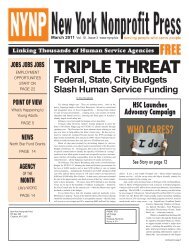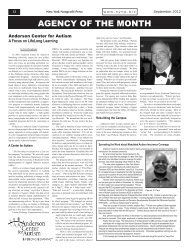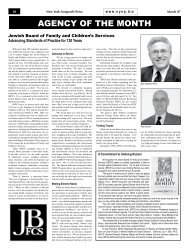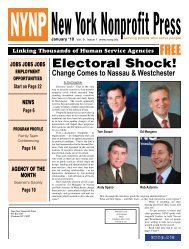September Edition 2004 - New York Nonprofit Press
September Edition 2004 - New York Nonprofit Press
September Edition 2004 - New York Nonprofit Press
Create successful ePaper yourself
Turn your PDF publications into a flip-book with our unique Google optimized e-Paper software.
8 <strong>New</strong> <strong>York</strong> <strong>Nonprofit</strong> <strong>Press</strong> www.nynp.biz <strong>September</strong> <strong>2004</strong><br />
NEW FACES F<br />
AT THE TOP<br />
Theresa A. Bischoff<br />
Chief Executive Officer<br />
American Red Cross in Greater <strong>New</strong> <strong>York</strong><br />
The American Red Cross in Greater <strong>New</strong><br />
<strong>York</strong> is always there at times of crisis. “We<br />
have a history of responding to eight emergencies<br />
or disasters a day here in the <strong>New</strong><br />
<strong>York</strong> area,” says Theresa A. Bischoff who<br />
joined the organization as CEO in January. Yet<br />
the events of <strong>September</strong> 11th have made the<br />
Red Cross’ mission even more important as<br />
<strong>New</strong> <strong>York</strong>ers face the need to prepare for<br />
calamities ranging from hurricanes to terrorist<br />
attacks of almost incomprehensible scale.<br />
“After 9/11, there was a lot of listening to<br />
what people felt the needs were and what the<br />
Red Cross had to do,” says Bischoff. “The<br />
‘preparedness’ mission is key.<br />
“We are committed to working with our<br />
government, other nonprofits and corporate<br />
partners to ensure that all 8.5 million people<br />
in our area are prepared for whatever emergency<br />
or disaster might happen. Whether it is<br />
a house fire, a blackout or a terrorist event, we<br />
want people to be prepared. That is a new focus<br />
and challenge for us.”<br />
In late February, ARC-GNY commissioned<br />
a survey to assess the state of readiness<br />
of individuals and small businesses for future<br />
crises. There was good news and bad news.<br />
“Over 90% of the people we surveyed said<br />
they knew they should be prepared,” says<br />
Bischoff. “About 40% said they had done<br />
something to prepare but only 22% had gotten<br />
fully prepared with a plan and a kit.”<br />
Why aren’t people taking steps to prepare<br />
for potential emergencies when they<br />
know how important it can be?<br />
“They told us they didn’t know what<br />
they were preparing for,” explains Bischoff.<br />
“We can help them with that. Preparing is<br />
something we can do for a whole range of<br />
things that might happen to us, anything<br />
from a single family fire or a water main<br />
break to a larger scale event like a blackout or<br />
a terrorist event. We can help them get over<br />
that barrier.”<br />
Bischoff stresses that fear of terrorism isn’t<br />
the only reason to plan ahead. “We got<br />
wonderful letters after the blackout from people<br />
who were prepared – people who had water,<br />
flashlights and comfortable shoes in their<br />
offices so they could walk home that night.<br />
They had taken our preparedness course in<br />
response to 9/11 but it was so helpful to them<br />
in dealing with the blackout.”<br />
The Red Cross survey also showed that<br />
people wanted hands on training to take<br />
them through the process of emergency planning.<br />
Since October of 2001, ARC-GNY has<br />
taught “Preparing for the Unexpected”, a free<br />
Photo Credit: Lou Manna<br />
60-minute class which teaches families what<br />
steps to take prior to and during an emergency,<br />
how to develop a plan and put together<br />
a disaster kit.<br />
“We offer it every week here at our headquarters<br />
and at our chapter locations,” says<br />
Bischoff. “We offered it to the City Council, to<br />
our State government supporters and we are<br />
participating with other groups to get the<br />
word out. We are probably offering it<br />
through every route you can imagine.<br />
“We are now partnering with corporations<br />
to offer it as ‘lunch and learn’ programs<br />
so their employees will have opportunities to<br />
get prepared,” Bischoff continues. “We are<br />
doing more and more of that.”<br />
ARC-NYC is also working closely with<br />
government organizations in its preparedness<br />
campaign. “We partner with OEM (<strong>New</strong><br />
<strong>York</strong> City’s Office of Emergency Management)<br />
in finding opportunities,” says<br />
Bischoff. “In <strong>September</strong>, as part of the Preparedness<br />
Month, we will be doing eight<br />
evenings of ‘Ready <strong>New</strong> <strong>York</strong>’ around the<br />
five boroughs, bringing all the programs we<br />
talk about -- making a plan, preparing a kit,<br />
getting trained in things like CPR, volunteering<br />
and giving blood.”<br />
In order to accommodate its enhanced<br />
disaster preparedness training effort, ARC-<br />
GNY’s has refined its organizational focus, divesting<br />
some programs less central to this<br />
new mandate. Until FY2003, homelessness<br />
shelters and programs accounted for approximately<br />
25% of ARC-GNY’s programmatic<br />
expenditures. “Over the past year, we have<br />
transitioned our homeless programs to other<br />
organizations,” says Bischoff. “So, we were<br />
able to assure that those programs got transferred<br />
as whole vital programs while allowing<br />
us to focus on our core mission.” While<br />
the strategic decision to divest these programs<br />
came prior to Bischoff’s arrival, she is<br />
fully supportive of the move. “Clearly, our<br />
new focus was going to take a lot of organizational<br />
energy. I think these were very good<br />
decisions.”<br />
Bischoff believes that ARC-GNY’s $30<br />
million annual budget fails to convey the true<br />
scope of the organization’s activity. “What<br />
you don’t see in that budget is the thousands<br />
and thousands of hours of volunteer time and<br />
in kind support we get,” she explains. “This<br />
organization is quite unique and extraordinary<br />
in the role that volunteers<br />
play. We have 7,000 volunteers,<br />
many of them highly trained and<br />
many of them who actually go<br />
out and do the core work of the<br />
organization. When we have a<br />
fire, it is very often only volunteers<br />
who, after very significant training, go<br />
out to provide the services that people expect<br />
from the Red Cross.”<br />
Bischoff is also confident that the work of<br />
these volunteers and the relief they provide to<br />
<strong>New</strong> <strong>York</strong>ers in crisis connects with potential<br />
donors. “The stories really are compelling,”<br />
says Bischoff. “On Father’s Day, we had a<br />
large fire in northern Manhattan and suddenly<br />
30 families were out on the street watching<br />
their building burn. Within minutes, the Red<br />
Cross was there making sure that people had<br />
blankets and clothes to put on and starting<br />
the process of thinking about how they would<br />
recover after losing their home and possessions.<br />
When you arrive on the scene of these<br />
disasters, wearing that Red Cross jacket, those<br />
we are there to help feel the sense of relief that<br />
help has arrived.”<br />
Now, Bischoff wants to get the word out.<br />
“Next year is our 100th birthday so it gives us<br />
an opportunity to re-acquaint ourselves with<br />
a lot of the audiences in <strong>New</strong> <strong>York</strong> who recognize<br />
the symbol but may not be as familiar<br />
with the work that we are doing today,” she<br />
says.<br />
And, she maintains, ARC-GNY needs<br />
that support. “We are able to do our work<br />
only because of the generosity and contributions<br />
of our donors,” she says. And, the<br />
fundraising environment has become more<br />
challenging. “What we saw substantially<br />
across all nonprofit organizations after 9/11<br />
was donor exhaustion and then, of course, the<br />
economic slowdown. I think we experienced<br />
that in a way that was consistent with other<br />
nonprofits. We are looking forward to the economic<br />
recovery and seeing more opportunities<br />
to fundraise.”<br />
Bischoff, who came to ARC-GNY after<br />
serving as President of NYU Medical Center,<br />
also wants to ramp up the organization’s<br />
own fundraising efforts. “In the past,<br />
a substantial amount of our funding had<br />
come through the United Way campaign.<br />
They have made some changes so we need<br />
to have that direct connection to our communities<br />
so they can provide us with the<br />
support we need.<br />
“We are looking forward to our centennial<br />
year as an opportunity to both share our<br />
work and engage corporations, individuals<br />
and government in supporting us in our mission<br />
to help all <strong>New</strong> <strong>York</strong>ers.”











